 Get premium membership
Get premium membership and access revision papers with marking schemes, video lessons and live classes.
Form 1 Physics End of Term 2 Examination 2022
Class: Form 1
Subject: Physics
Level: High School
Exam Category: Form 1 End Term 2 Exams
Document Type: Pdf
Views: 1169
Downloads: 32
Exam Summary
1. Figure 1 below shows a bimetallic strip in a fire alarm. Explain how it can be used to set the alarm on during fire outbreak. (2mks)
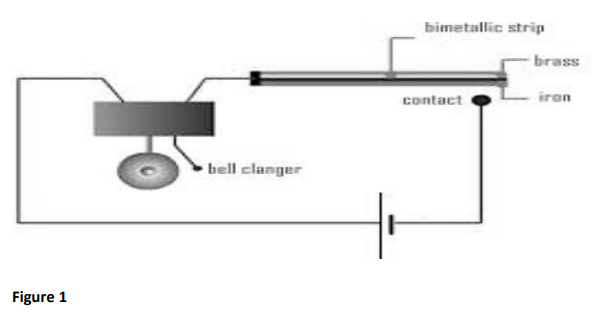
2. State the possible instrument in the laboratory that can be used to obtain the following readings:
(a) 28.1cm.………………………………………(1mk)
(b) 9.45 seconds. ……………………………………… (1mk)
3. Mercury on a clean glass slide collects into small spherical balls as shown in figure 2 below. Explain why(1mk)

4. A person’s lung pressure as recorded by a mercury manometer is 90 mmHg. Express this pressure in SI units. (density of mercury is 13600 Kgm-3, Take g = 10 Nkg-1) (2 marks)
5. In an experiment to demonstrate Brownian motion, smoke was placed in a cell and observed under a microscope. Smoke particles were observed to move randomly in the cell. Explain the observation.(1 mark)
6. State two applications of convection in daily life.(2 marks)
7. State any two laboratory safety rules. (2mks)
8. Explain why it is easier to ride a bicycle round a bend on a road if the surface is dry than when it is wet. (1mk)
9. The weight of an object on earth is 20 N. If the object weighs 18 N on another planet, determine the gravitational field strength at the planet. (Take g on earth = 10 Nkg-1)
10. 1600 cm3 of fresh water of density l g/cm3 are mixed with 1400cm3 of seawater of density 1.25g/cm3. Determine the density of the mixture. (3 marks)
11. The barometric height at sea level is 76cm of mercury while at a point on a highland it is 74cm of mercury. What is the altitude of the point? (density of mercury = 13600kg/m3
and density of air as 1.25kg/m3,Take g= 10 Nkg-1 ) (3 marks)
12. . A metal stipple was observed to float on the surface of water in a beaker. The stipple sank immediately some detergent was added to the water. Explain this observation (1 mark)
13. The volume of one drop of a liquid was found to be 0.045 ml. If 30 drops were delivered by a burette from an initial reading of the liquid being 11.4 ml, find the final reading of the liquid.(3 marks)
SECTION B: 50 MARKS
Answer ALL the questions in this section in the spaces provided
14. (a) Define density and state its SI unit. (1 mark)
(b) Describe a procedure to determine the density of an Irregular sinking objects, for example, stone. (4 marks)
(c) During a class activity to estimate the area of irregularly shaped surfaces, Form one students were provided with graph papers .Describe how a student would use this to estimate the area of an irregularly shaped body ( i.e. the palm of their hands) (3marks)
(d) Figure 3 below shows an object of volume 300cm3 placed on the pan of a beam balance. The pointer was initially at the zero mark Determine the density of the object in Kgm-3
(3 marks)
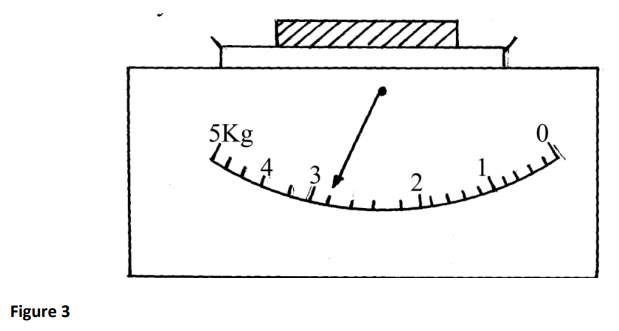
15. (a) State the kinetic theory of matter (1mark)
(b) You are provided with a long glass-tube, fitting corks, cotton wool, concentrated solution hydrochloric
acid and concentrated ammonia solution.
(i) Draw a possible set-up to compare the rates of diffusion of ammonia gas and hydrochloric acid gas (2 marks)
(ii) Show where the deposits are formed. (1 mark)
(iii) Explain the observation. (2 marks)
(c) Explain why:
(i) Solids have a definite shape, and don’t flow. (2 marks)
(ii) Solids and liquids have a fixed size but gases fill the container they are in ( 2 marks)
16. (a) Define force and state its S.I unit. (2 marks)
(b) State three effects of force. (3 marks)
(c) Figure 4 below shows a needle placed on the surface of a liquid.
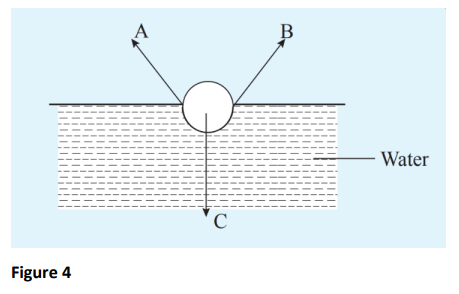
Name the forces A, B and C acting on the needle( 3 marks)
(d) Differentiate between mass and weight. (1 mark)
(e) Calculate the weight of the following A metal box of mass 0.65 tonnes on a planet where g = 6.0 Nkg-1 (2 mark)
17. (a) Define pressure, and state its SI units. ( 2 marks)
(b) A solid block measuring 6.5 cm by 8.0 cm by 12.5 cm is made of a material of density 8.93 kg/m3. Determine the maximum and minimum pressure it can exert when resting on a horizontal surface
(c) (i) State the principle of transmission of pressure in fluids.(1 mark)
(ii) The following diagram shows a hydraulic press with two pistons A and B of areas 25cm2 and 1200 cm2 respectively. Find the force generated on piston B if a force of 135 N is applied on piston A. (3 marks)
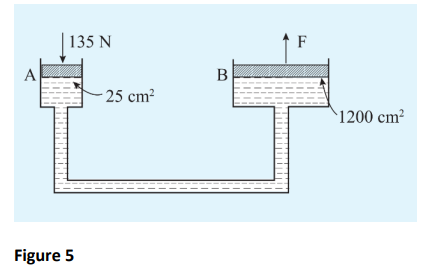
(d) A student fills a balloon with water. She then uses a pin to poke holes in the plastic while she squeezed the bag gently.
(i) What does she observe? (1mk)
(ii) Explain the observation stated. (2mks)
18. (a) Differentiate between heat and temperature. (1 mark)
(b)Figure 6 below shows a flask containing air connected to a long glass tube and inverted into a beaker of water.
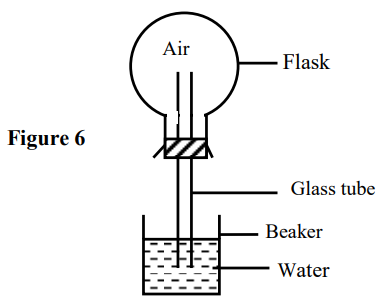
State and explain what is observed when the flask is gently warmed. (2mks)
(c)Explain why aquatic animals are able to survive under water when the surface is already frozen. (1mk)
(d).State two features in a thermos flask which reduce heat loss by conduction. (2mks)
(e)Convert the following from Kelvin scale to degrees Celsius. (2mks)
(i) 46.9K
(ii) -206K
(f) State two properties of a liquid that is suitable for use in a thermometer (2 marks)
More Examination Papers